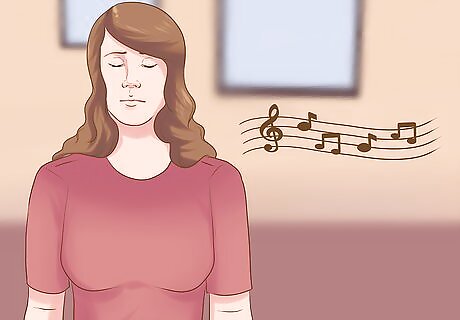
views
Humming Through the Nose

Begin singing a note. Open your mouth and begin vocalizing a certain note or pitch. Keep your lips parted slightly and your jaw, throat and diaphragm relaxed. You should feel the vibrations of the note originating at your vocal cords. The only real difference between singing and humming is that when humming, the movements of the mouth are taken out of the equation.

Close your mouth. As you continue singing, bring your lips together and seal them so that no sound escapes through your mouth. This redirects the sound so that is channeled through the nose, sinuses and bones of the face. It also blunts your ability to clarify and enunciate the note, resulting in the characteristic “humming” noise. Humming is amplified to both the hummer and the listener by the movement of sound vibrations through facial bones and cavities. If you’re not much of a singer, you can also try simply pursing your lips and making a “hmmm” noise as if you were thinking.

Feel the vibration emerging from your nose. Keep humming. After you close your mouth, the path of the vibrations will shift from the throat up and out through the nostrils. Notice the tiny, rapid vibrations in your nose and the roof of your mouth. You may feel a tickling or buzzing sensation. This is the “basic” form of humming that most people know how to do. Humming through the nose will result in a higher-pitched, more nasal quality.

Change pitch at will. At this point, you are officially humming. Experiment with different pitches and sounds. Force more air through the nostrils to raise your pitch, and lower the vibrations deeper into your throat to lower it. The pitch you are able to attain should closely match that of your normal singing voice, though you may be able to hit notes that are even higher or lower while you’re humming.
Humming Through the Mouth

Hum as you ordinarily would. For this technique, you will change the point of resonance of the hum to better project the sound of your voice. Start humming. Make a note of where you feel the vibrations from the sound most strongly. You should be able to “follow” the humming vibrations as they carry through the throat, nose and mouth.

Open up your throat. Continue vocalizing, keeping your mouth closed and your jaw relaxed. Now, as you hum, allow your throat to expand as though you were coughing or attempting to hit the lowest note you possibly can. Your larynx will tighten and draw downward. Getting your throat in the right position is not as easy as it sounds. Work on lowering the pitch of the notes as you hum and try to feel when your larynx sinks. With a little practice, you’ll get the hang of it.

Focus the sound through the mouth. You are now in a better position to project the hum through your mouth. Let the vibrations fill your cheeks. Push with your diaphragm as you exhale. If you feel a tickle in your lips or the lower portion of your face begins to tingle, you’re doing it right. Keep your lips tightly sealed so that the sound is amplified by your throat and the hollows of your cheeks. Projecting through the mouth lets you hum, and therefore sing, with greater volume and clarity.

Get as much volume as you can. Now that you’re able to project the vibrations of your vocal cords through your mouth, try to hum more forcefully. Squeeze your diaphragm to push more air out and keep your throat opened up. You should be able to achieve a louder, more booming hum this way than the thin, nasally quality of the basic technique of humming through the nose. Most of your volume should come from the diaphragm, not the voice box. It is only being conducted through the mouth. This is the “right” way to hum as a trained singer.
Humming as a Vocal Warm-Up

Hum to prepare your vocal cords. Just as an athlete limbers up before exercising, it’s important to warm up your voice before doing any singing, public speaking or yelling. Spend a few minutes humming to work out the tension in your voicebox. Humming is a great way to get your vocal cords loose and ready for the stress of projecting sound. It is possible to damage your voice if you produce loud, prolonged sounds without a proper warm-up. Warming up your vocal cords can even make your normal speaking voice smoother and more pleasant.

Alternate between a high and low hum. When getting ready to sing or deliver a speech, try getting your voice ready by humming in different pitches. Carry the sound through both your nose and your mouth, switching from one to the other as you transition. Hit each note as high or as low as you can. The higher the hum, the more you will feel it in your nose and up in the sinuses and forehead. As you lower the note, the vibrations will sink into your throat and resound in your chest.

Run through musical scales. Singers can incorporate humming into their vocal warm-up exercises with great results. Practice reciting harmonic scales the way you ordinarily would, only hum rather than sing. Maintain a steady, constant pitch as you work your way through the ascending and descending notes. Good singing technique should be observed before you even open your mouth! Humming eliminates the need to focus on lyrics or shape words as you warm up, allowing you to focus purely on hitting the right pitch.

Hum as you breathe. Humming can be very relaxing when used as a meditation technique. Find a quiet place to sit and relax your throat and diaphragm. Take a deep breath in and hold it for a moment or two. Release the breath slowly, humming as you exhale. The hum should ride out naturally on top of the breath. During this exercise, you should not be making an attempt to project or exhale forcefully. Simply let the hum escape as you breathe. Exhale and hold a gentle hum for as long as you can. Humming while breathing is a good way to clear your head, relax your body and alleviate stress.














Comments
0 comment